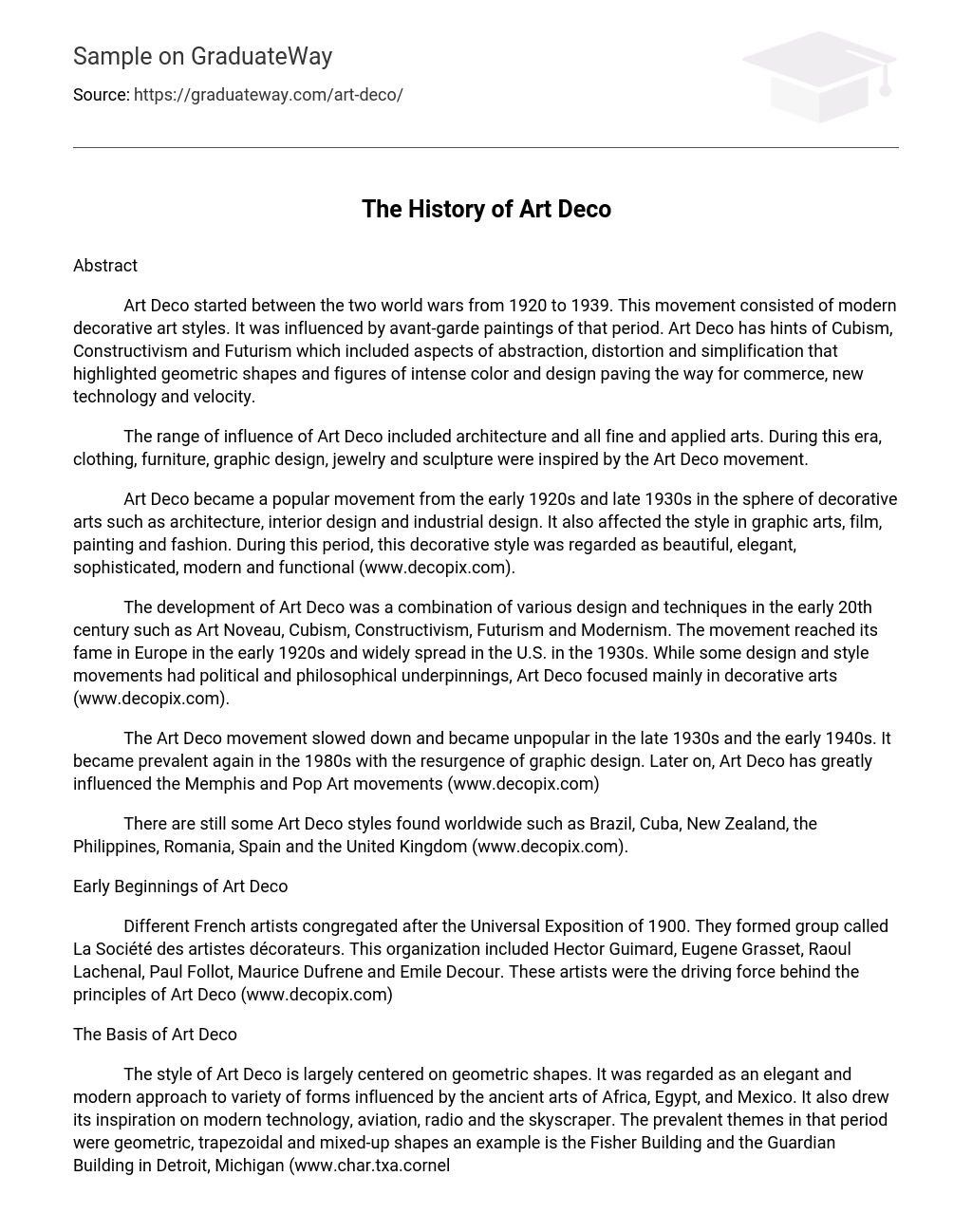Abstract
Art Deco started between the two world wars from 1920 to 1939. This movement consisted of modern decorative art styles. It was influenced by avant-garde paintings of that period. Art Deco has hints of Cubism, Constructivism and Futurism which included aspects of abstraction, distortion and simplification that highlighted geometric shapes and figures of intense color and design paving the way for commerce, new technology and velocity.
The range of influence of Art Deco included architecture and all fine and applied arts. During this era, clothing, furniture, graphic design, jewelry and sculpture were inspired by the Art Deco movement.
Art Deco became a popular movement from the early 1920s and late 1930s in the sphere of decorative arts such as architecture, interior design and industrial design. It also affected the style in graphic arts, film, painting and fashion. During this period, this decorative style was regarded as beautiful, elegant, sophisticated, modern and functional (www.decopix.com).
The development of Art Deco was a combination of various design and techniques in the early 20th century such as Art Noveau, Cubism, Constructivism, Futurism and Modernism. The movement reached its fame in Europe in the early 1920s and widely spread in the U.S. in the 1930s. While some design and style movements had political and philosophical underpinnings, Art Deco focused mainly in decorative arts (www.decopix.com).
The Art Deco movement slowed down and became unpopular in the late 1930s and the early 1940s. It became prevalent again in the 1980s with the resurgence of graphic design. Later on, Art Deco has greatly influenced the Memphis and Pop Art movements (www.decopix.com)
There are still some Art Deco styles found worldwide such as Brazil, Cuba, New Zealand, the Philippines, Romania, Spain and the United Kingdom (www.decopix.com).
Early Beginnings of Art Deco
Different French artists congregated after the Universal Exposition of 1900. They formed group called La Société des artistes décorateurs. This organization included Hector Guimard, Eugene Grasset, Raoul Lachenal, Paul Follot, Maurice Dufrene and Emile Decour. These artists were the driving force behind the principles of Art Deco (www.decopix.com)
The Basis of Art Deco
The style of Art Deco is largely centered on geometric shapes. It was regarded as an elegant and modern approach to variety of forms influenced by the ancient arts of Africa, Egypt, and Mexico. It also drew its inspiration on modern technology, aviation, radio and the skyscraper. The prevalent themes in that period were geometric, trapezoidal and mixed-up shapes an example is the Fisher Building and the Guardian Building in Detroit, Michigan (www.char.txa.cornell.edu).
Design and Fabrication
Art Deco was exemplified by the use of aluminum, inlaid wood, lacquer and stainless steel. The utilization of racy curves, chevron designs and sunburst motif typifies Art Deco. The sunburst motif was popular in ladies’ shoes design, and seen as a decorative style in radiator grilles and buildings such as the spines in the Chrysler Building in New York (www.char.txa.cornell.edu).
Art Deco commemorates the Machine Age through its use of man-made materials such as glass and stainless steel and application of repetition and symmetry (www.char.txa.cornell.edu).
How to Recognize an Art Deco Design
There are different ways to distinguish Art Deco from other art movements. The first step is to look for clean sinuous lines and shapes. Curves, sweeping lines and asymmetrical designs were always present in Art Deco style. The second step is to find bold geometric shapes with contrasting colors and textures. The third step is to examine the materials used such as aluminum, chrome, glass, wood or plastic with brand names like Bakelite and Catalin were characteristics of the Art Deco movement. The fourth step is to search for figural elements like female figures. The exciting period of the 1920s introduced new fashion trends for women such as higher hemlines and clinging fabrics. There is a new found freedom in the Art Deco design (www.pheebay.com).
Lastly, take into account the similarities and differences between other styles and movements which developed at the same time such as Moderne, Bauhaus and Machine age (www.pheebay.com)
References
Jirousek, Charlotte. (1995). Art, Design and Visual Thinking: Art Deco. http://www.char.txa.cornell.edu/
artdeco/htm. Retrieved on April 23, 2009.
Juster, Randy.(2008). Introduction to Art Deco. http://www.decopix.com. Retrieved on April 23, 2009
“So What is Art Deco Design?” http://www.pheebay.com. Retrieved on April 23, 2009.





